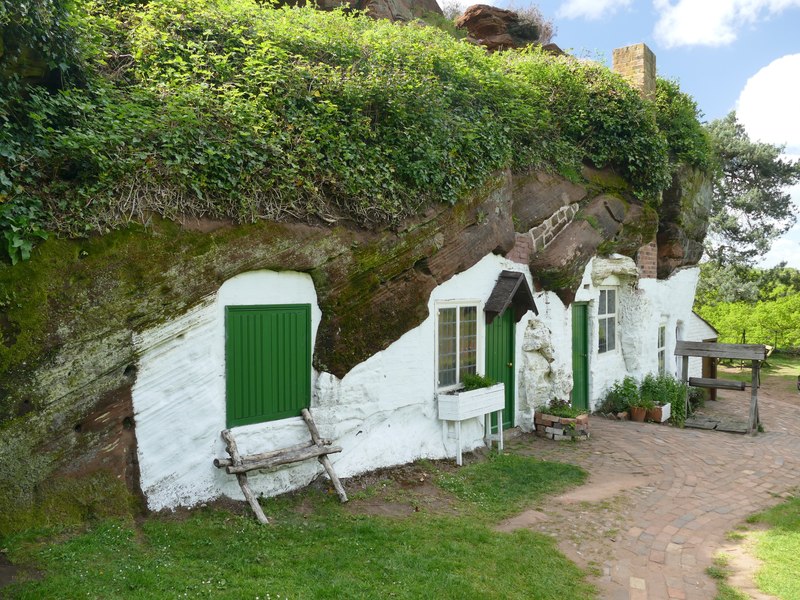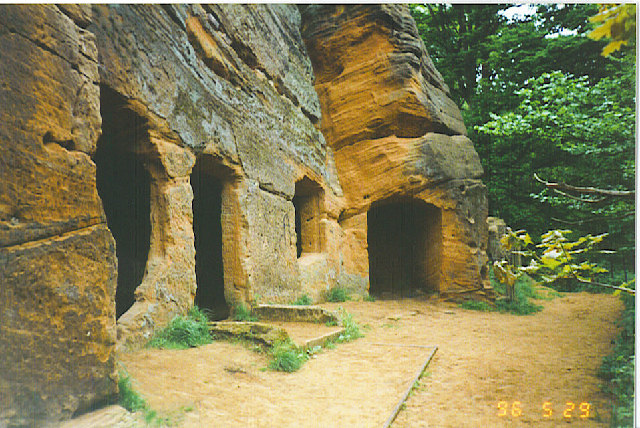Holy Austin rock houses

|
| Set in sandstone below Kinver Edge, the Holy Austin rock houses were inhabited until the 1960s. They have been restored and are owned by the National Trust. cc-by-sa/2.0 - © Graham Hogg - geograph.org.uk/p/5773126 |
[edit] Introduction
Also referred to as troglodyte dwellings, the Holy Austin rock houses are located in Kinver, England. Carved into the 250-million-year old sandstone cliff, these tiered cave homes were inhabited for more than 400 years.
Although the dwellings may go back to the early 17th century, the first recorded occupant was Joseph Heely, who lived in one of the rock houses in 1777. The softness of the sandstone made it easy to create new rooms. By 1860, 11 houses had been carved into Holy Austin to provide homes for 44 people.
There are other rock houses on Kinver Edge, including:
- Nanny's Rock (also known as 'Meg-o-Fox-Hole’) has five compartments but it is not known if it was ever converted into a house.
- Vale's Rock (also known as Crow's Rock) was converted into a house with several levels.
[edit] Rise and fall of the rock houses
In addition to the rock houses, a tearoom was established for visitors who wished to enjoy the countryside. The cafe operated until 1967, even after the occupants had moved away. Once the cafe closed, the homes fell into disrepair. Vandalism and nature combined to destroy the properties until the Natural Trust took over ownership in the 1990s.
Restoration work began in 1993, and one of the upper houses was restored as a family home based on photographs through the course of time. The original gardens were also found and restored.

|
| This photo the rock houses for troglodytes before their restoration. |
The second phase of restoration work began in 1996 on the lower level. This home had its own ‘ballroom’ according to photographic evidence and once belonged to a family that had been the subject of a painting by Alfred Rushton. Details in the painting were also used to help complete the project. The rock house is now decorated in the style of a Victorian home.
The rock houses are open to tourists.
[edit] Related articles on Designing Buildings Wiki
IHBC NewsBlog
Images from inside a Grade II listed hotel show the scale of its collapse
The Corbett Arms in Tywyn has fallen into serious disrepair.
Old Sarum fire in listed (& disputed) WW1 Hangar - Wiltshire Council has sought legal advice after fire engulfed a listed First World War hangar that was embroiled in a lengthy planning dispute.
UK Antarctic Heritage Trust launches ‘Virtual Visit’ website area
The Trust calls on people to 'Immerse yourself in our heritage – Making Antarctica Accessible'
Southend Council pledge to force Kursaal owners to maintain building
The Council has pledged to use ‘every tool in the toolbox’ if urgent repairs are not carried out.
HE’s Research Magazine publishes a major study of the heritage of England’s suburbs
The article traces the long evolution of an internal programme to research 200 years of suburban growth
IHBC Context 183 Wellbeing and Heritage published
The issue explores issues at the intersection of heritage and wellbeing.
SAVE celebrates 50 years of campaigning 1975-2025
SAVE Britain’s Heritage has announced events across the country to celebrate bringing new life to remarkable buildings.
IHBC Annual School 2025 - Shrewsbury 12-14 June
Themed Heritage in Context – Value: Plan: Change, join in-person or online.
200th Anniversary Celebration of the Modern Railway Planned
The Stockton & Darlington Railway opened on September 27, 1825.
Competence Framework Launched for Sustainability in the Built Environment
The Construction Industry Council (CIC) and the Edge have jointly published the framework.













